DODGE POWER WAGON 2007 2.G Manual PDF
Manufacturer: DODGE, Model Year: 2007, Model line: POWER WAGON, Model: DODGE POWER WAGON 2007 2.GPages: 492, PDF Size: 8.25 MB
Page 71 of 492
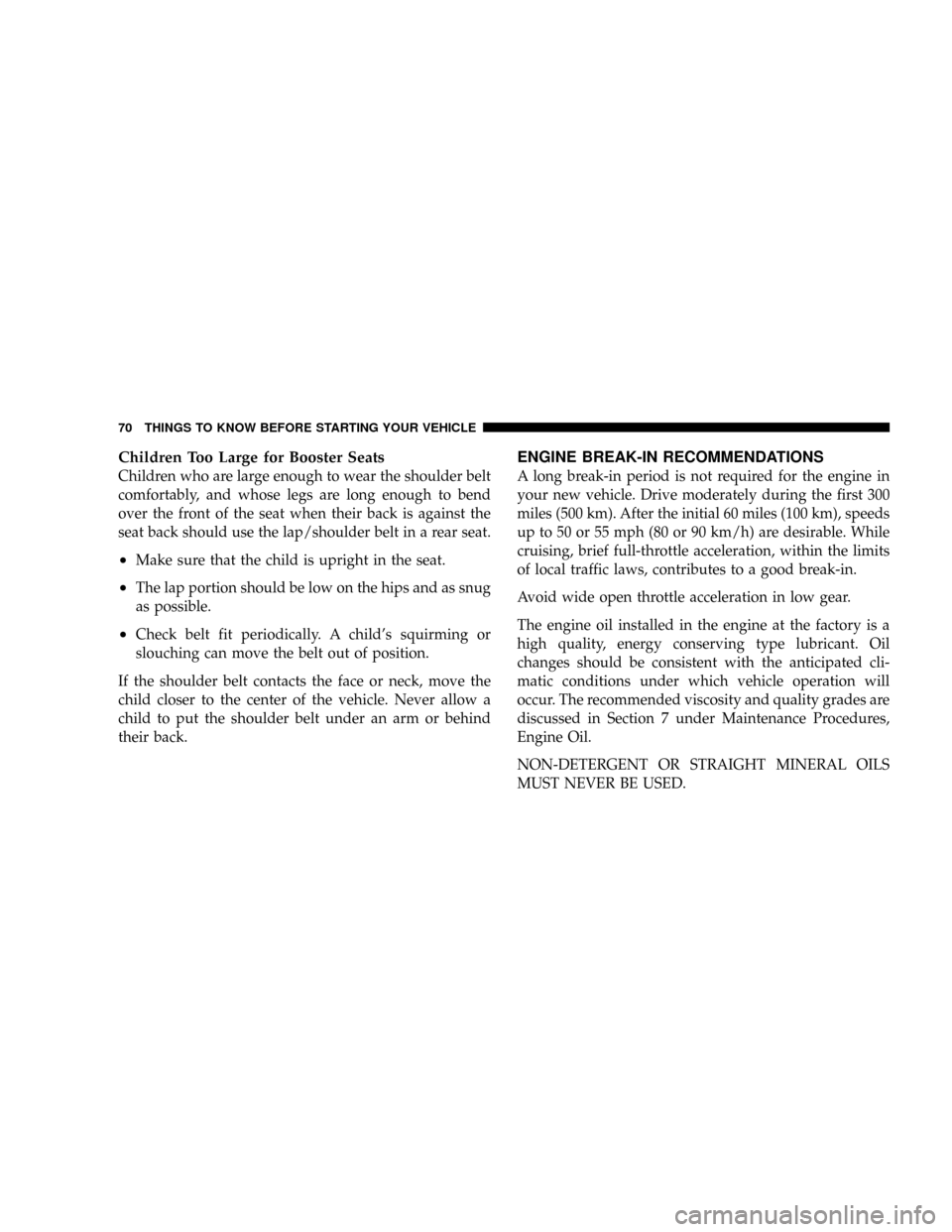
Children Too Large for Booster Seats
Children who are large enough to wear the shoulder belt
comfortably, and whose legs are long enough to bend
over the front of the seat when their back is against the
seat back should use the lap/shoulder belt in a rear seat.
²Make sure that the child is upright in the seat.
²The lap portion should be low on the hips and as snug
as possible.
²Check belt fit periodically. A child's squirming or
slouching can move the belt out of position.
If the shoulder belt contacts the face or neck, move the
child closer to the center of the vehicle. Never allow a
child to put the shoulder belt under an arm or behind
their back.
ENGINE BREAK-IN RECOMMENDATIONS
A long break-in period is not required for the engine in
your new vehicle. Drive moderately during the first 300
miles (500 km). After the initial 60 miles (100 km), speeds
up to 50 or 55 mph (80 or 90 km/h) are desirable. While
cruising, brief full-throttle acceleration, within the limits
of local traffic laws, contributes to a good break-in.
Avoid wide open throttle acceleration in low gear.
The engine oil installed in the engine at the factory is a
high quality, energy conserving type lubricant. Oil
changes should be consistent with the anticipated cli-
matic conditions under which vehicle operation will
occur. The recommended viscosity and quality grades are
discussed in Section 7 under Maintenance Procedures,
Engine Oil.
NON-DETERGENT OR STRAIGHT MINERAL OILS
MUST NEVER BE USED.
70 THINGS TO KNOW BEFORE STARTING YOUR VEHICLE
Page 72 of 492
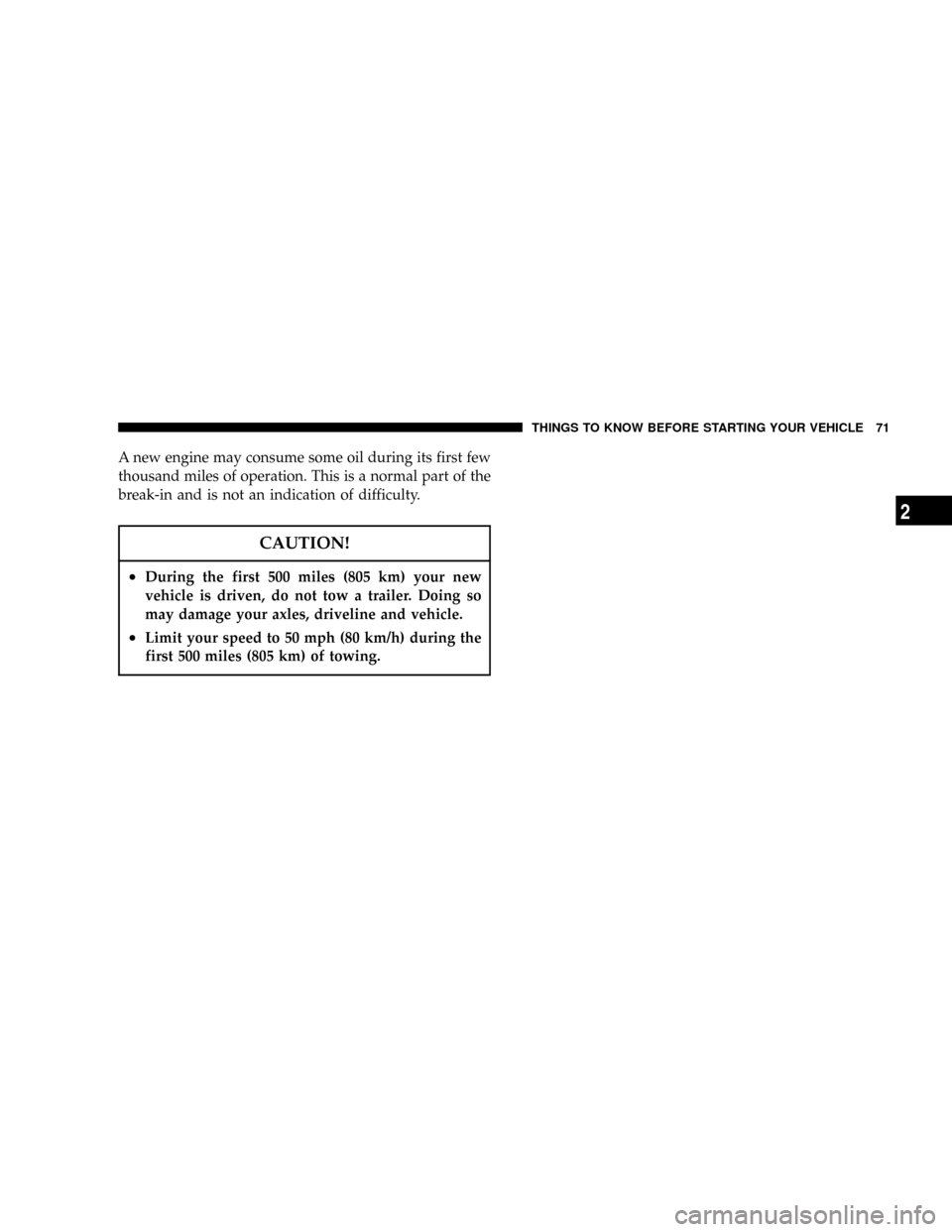
A new engine may consume some oil during its first few
thousand miles of operation. This is a normal part of the
break-in and is not an indication of difficulty.
CAUTION!
²During the first 500 miles (805 km) your new
vehicle is driven, do not tow a trailer. Doing so
may damage your axles, driveline and vehicle.
²Limit your speed to 50 mph (80 km/h) during the
first 500 miles (805 km) of towing.
THINGS TO KNOW BEFORE STARTING YOUR VEHICLE 71
2
Page 73 of 492

Page 74 of 492
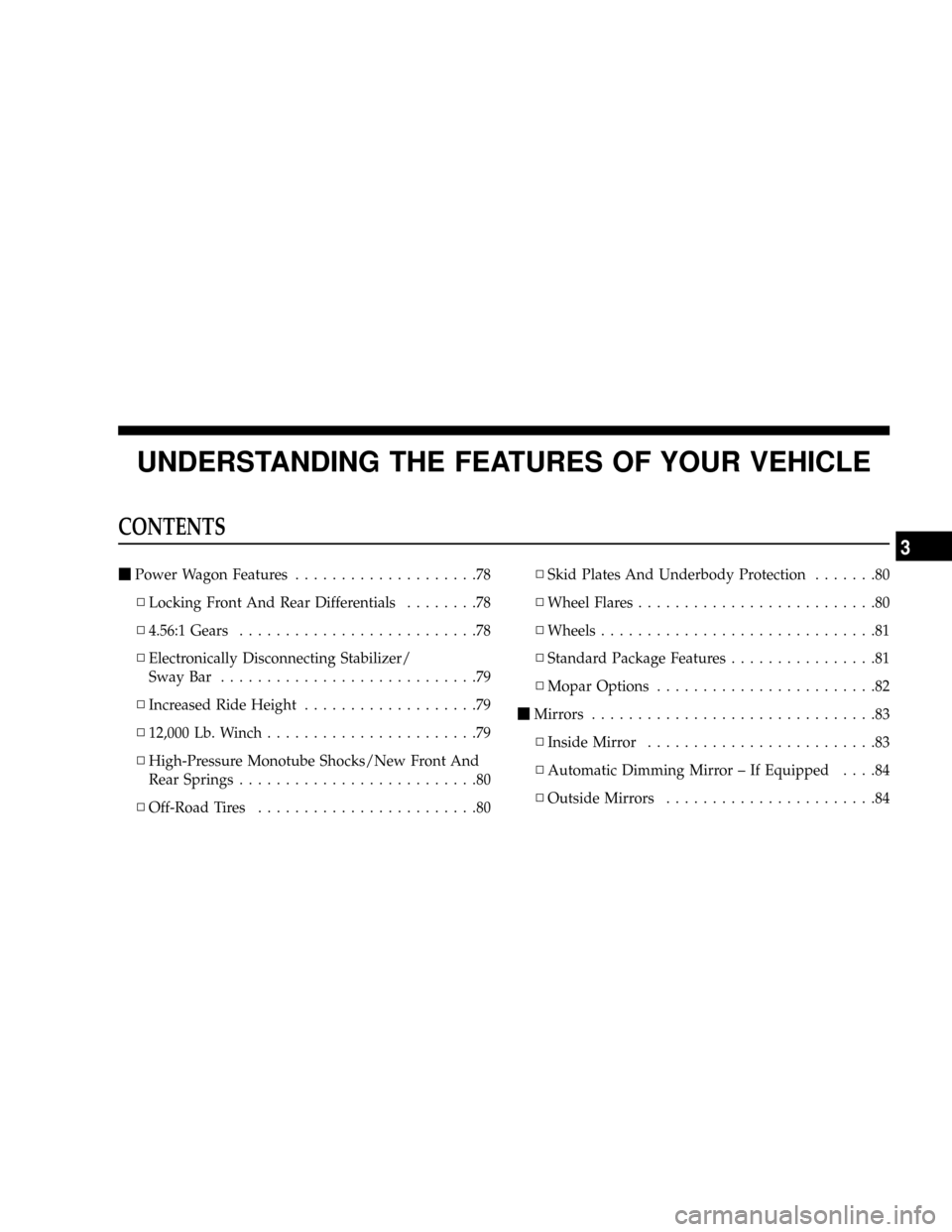
UNDERSTANDING THE FEATURES OF YOUR VEHICLE
CONTENTS
mPower Wagon Features....................78
NLocking Front And Rear Differentials........78
N4.56:1 Gears..........................78
NElectronically Disconnecting Stabilizer/
Sway Bar............................79
NIncreased Ride Height...................79
N12,000 Lb. Winch.......................79
NHigh-Pressure Monotube Shocks/New Front And
Rear Springs..........................80
NOff-Road Tires........................80NSkid Plates And Underbody Protection.......80
NWheel Flares..........................80
NWheels..............................81
NStandard Package Features................81
NMopar Options........................82
mMirrors...............................83
NInside Mirror.........................83
NAutomatic Dimming Mirror ± If Equipped....84
NOutside Mirrors.......................84
3
Page 75 of 492
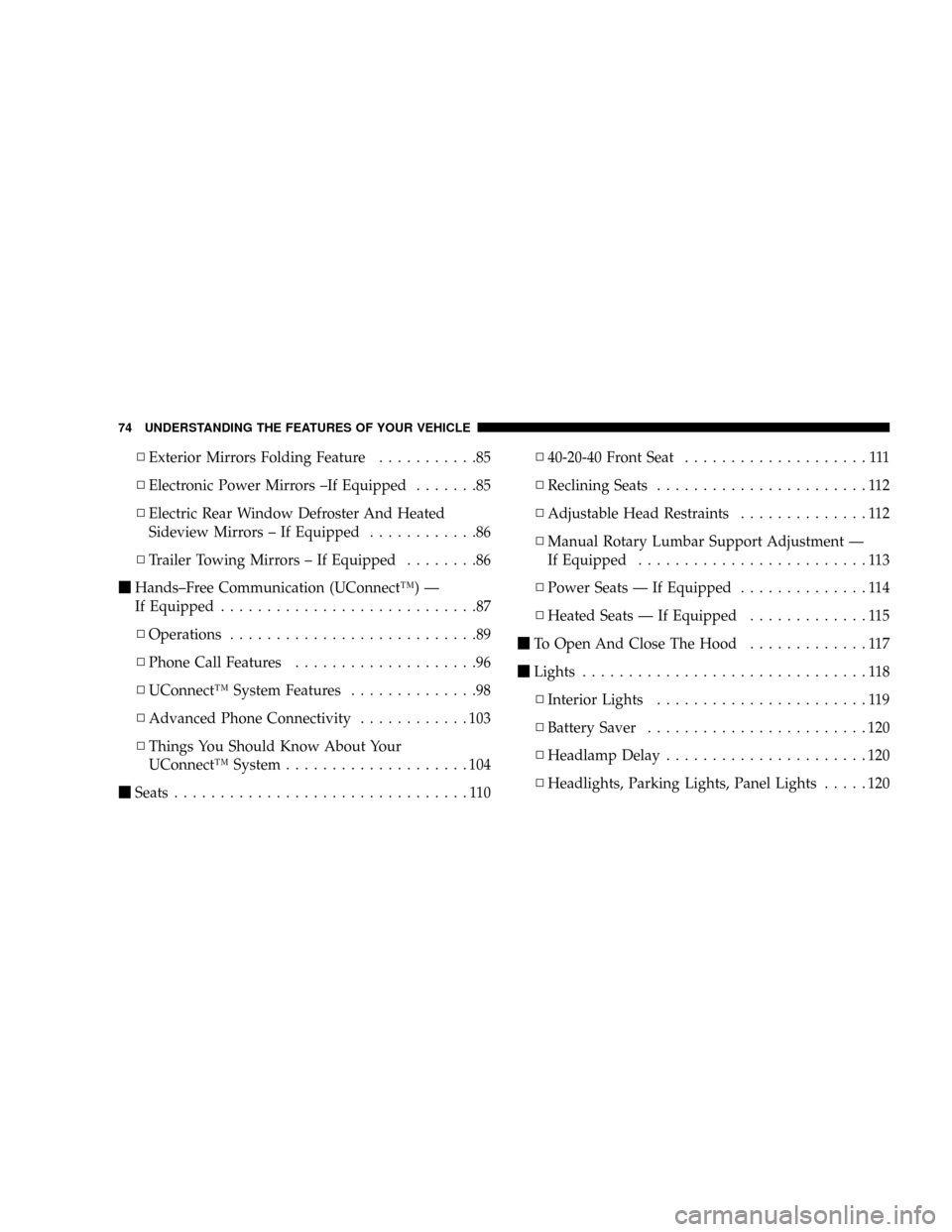
NExterior Mirrors Folding Feature...........85
NElectronic Power Mirrors ±If Equipped.......85
NElectric Rear Window Defroster And Heated
Sideview Mirrors ± If Equipped............86
NTrailer Towing Mirrors ± If Equipped........86
mHands±Free Communication (UConnectŸ) Ð
If Equipped............................87
NOperations...........................89
NPhone Call Features....................96
NUConnectŸ System Features..............98
NAdvanced Phone Connectivity............103
NThings You Should Know About Your
UConnectŸ System....................104
mSeats................................110N40-20-40 Front Seat....................111
NReclining Seats.......................112
NAdjustable Head Restraints..............112
NManual Rotary Lumbar Support Adjustment Ð
If Equipped.........................113
NPower Seats Ð If Equipped..............114
NHeated Seats Ð If Equipped.............115
mTo Open And Close The Hood.............117
mLights...............................118
NInterior Lights.......................119
NBattery Saver........................120
NHeadlamp Delay......................120
NHeadlights, Parking Lights, Panel Lights.....120
74 UNDERSTANDING THE FEATURES OF YOUR VEHICLE
Page 76 of 492
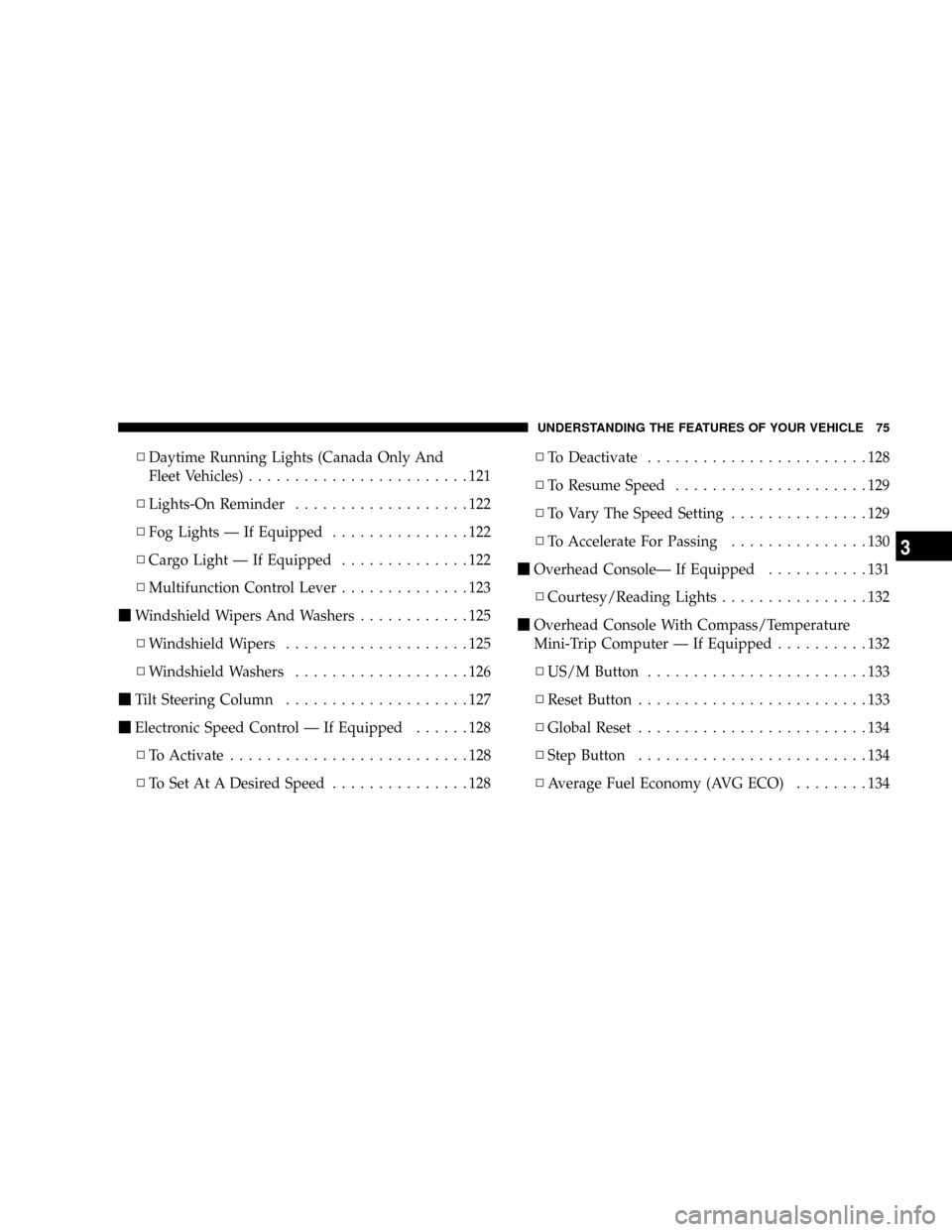
NDaytime Running Lights (Canada Only And
Fleet Vehicles)........................121
NLights-On Reminder...................122
NFog Lights Ð If Equipped...............122
NCargo Light Ð If Equipped..............122
NMultifunction Control Lever..............123
mWindshield Wipers And Washers............125
NWindshield Wipers....................125
NWindshield Washers...................126
mTilt Steering Column....................127
mElectronic Speed Control Ð If Equipped......128
NTo Activate..........................128
NTo Set At A Desired Speed...............128NTo Deactivate........................128
NTo Resume Speed.....................129
NTo Vary The Speed Setting...............129
NTo Accelerate For Passing...............130
mOverhead ConsoleÐ If Equipped...........131
NCourtesy/Reading Lights................132
mOverhead Console With Compass/Temperature
Mini-Trip Computer Ð If Equipped..........132
NUS/M Button........................133
NReset Button.........................133
NGlobal Reset.........................134
NStep Button.........................134
NAverage Fuel Economy (AVG ECO)........134
UNDERSTANDING THE FEATURES OF YOUR VEHICLE 75
3
Page 77 of 492
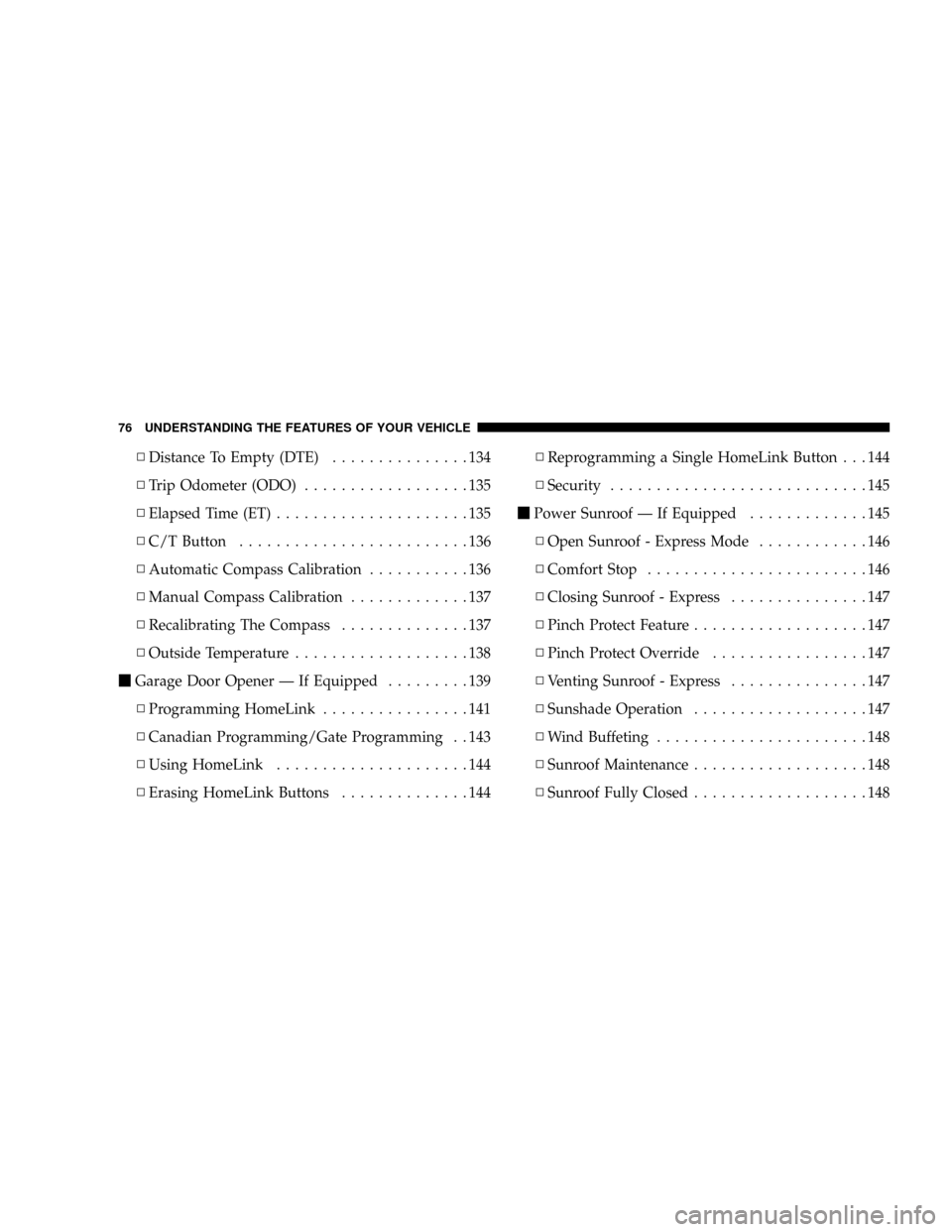
NDistance To Empty (DTE)...............134
NTrip Odometer (ODO)..................135
NElapsed Time (ET).....................135
NC/T Button.........................136
NAutomatic Compass Calibration...........136
NManual Compass Calibration.............137
NRecalibrating The Compass..............137
NOutside Temperature...................138
mGarage Door Opener Ð If Equipped.........139
NProgramming HomeLink................141
NCanadian Programming/Gate Programming . . 143
NUsing HomeLink.....................144
NErasing HomeLink Buttons..............144NReprogramming a Single HomeLink Button . . . 144
NSecurity............................145
mPower Sunroof Ð If Equipped.............145
NOpen Sunroof - Express Mode............146
NComfort Stop........................146
NClosing Sunroof - Express...............147
NPinch Protect Feature...................147
NPinch Protect Override.................147
NVenting Sunroof - Express...............147
NSunshade Operation...................147
NWind Buffeting.......................148
NSunroof Maintenance...................148
NSunroof Fully Closed...................148
76 UNDERSTANDING THE FEATURES OF YOUR VEHICLE
Page 78 of 492
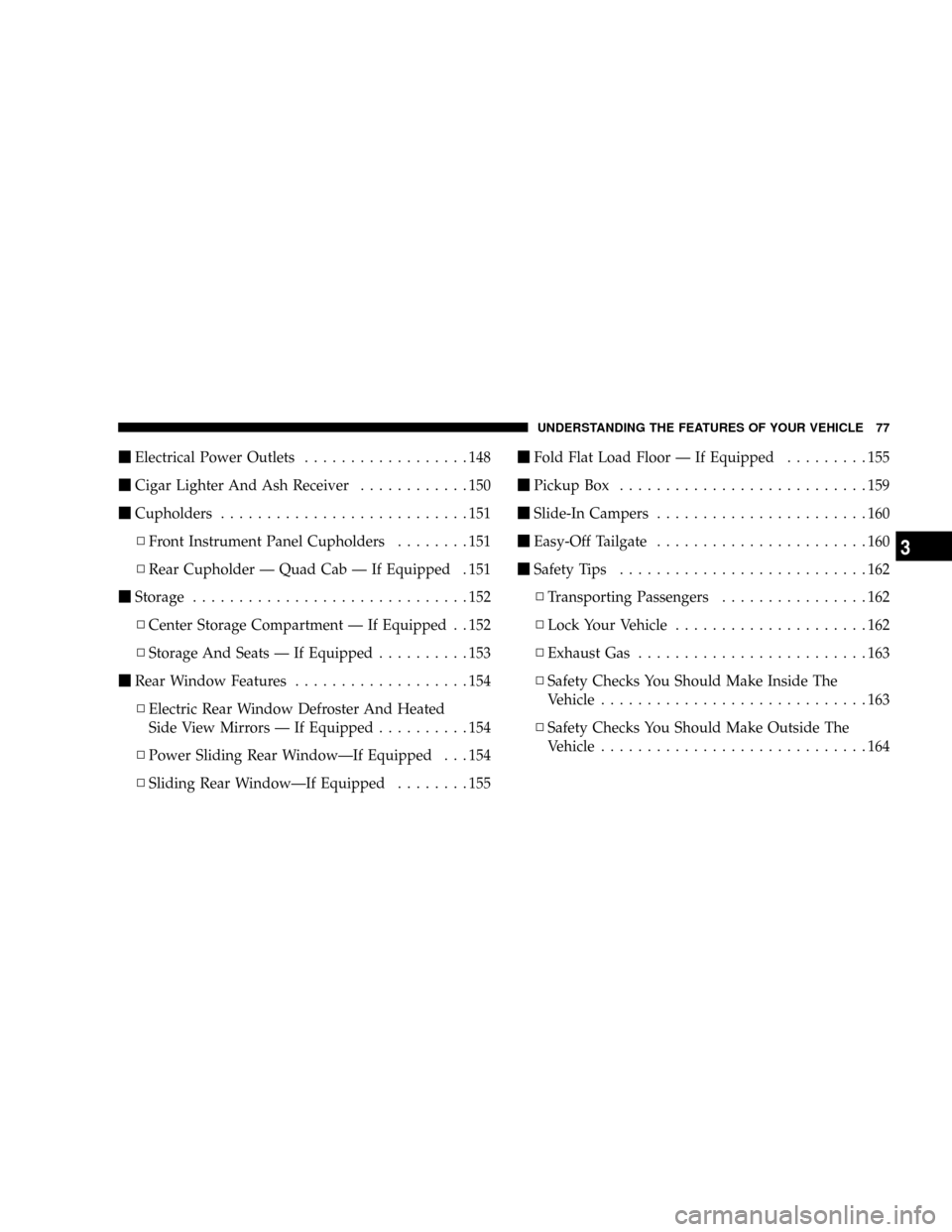
mElectrical Power Outlets..................148
mCigar Lighter And Ash Receiver............150
mCupholders...........................151
NFront Instrument Panel Cupholders........151
NRear Cupholder Ð Quad Cab Ð If Equipped . 151
mStorage..............................152
NCenter Storage Compartment Ð If Equipped . . 152
NStorage And Seats Ð If Equipped..........153
mRear Window Features...................154
NElectric Rear Window Defroster And Heated
Side View Mirrors Ð If Equipped..........154
NPower Sliding Rear WindowÐIf Equipped . . . 154
NSliding Rear WindowÐIf Equipped........155mFold Flat Load Floor Ð If Equipped.........155
mPickup Box...........................159
mSlide-In Campers.......................160
mEasy-Off Tailgate.......................160
mSafety Tips...........................162
NTransporting Passengers................162
NLock Your Vehicle.....................162
NExhaust Gas.........................163
NSafety Checks You Should Make Inside The
Vehicle.............................163
NSafety Checks You Should Make Outside The
Vehicle.............................164
UNDERSTANDING THE FEATURES OF YOUR VEHICLE 77
3
Page 79 of 492
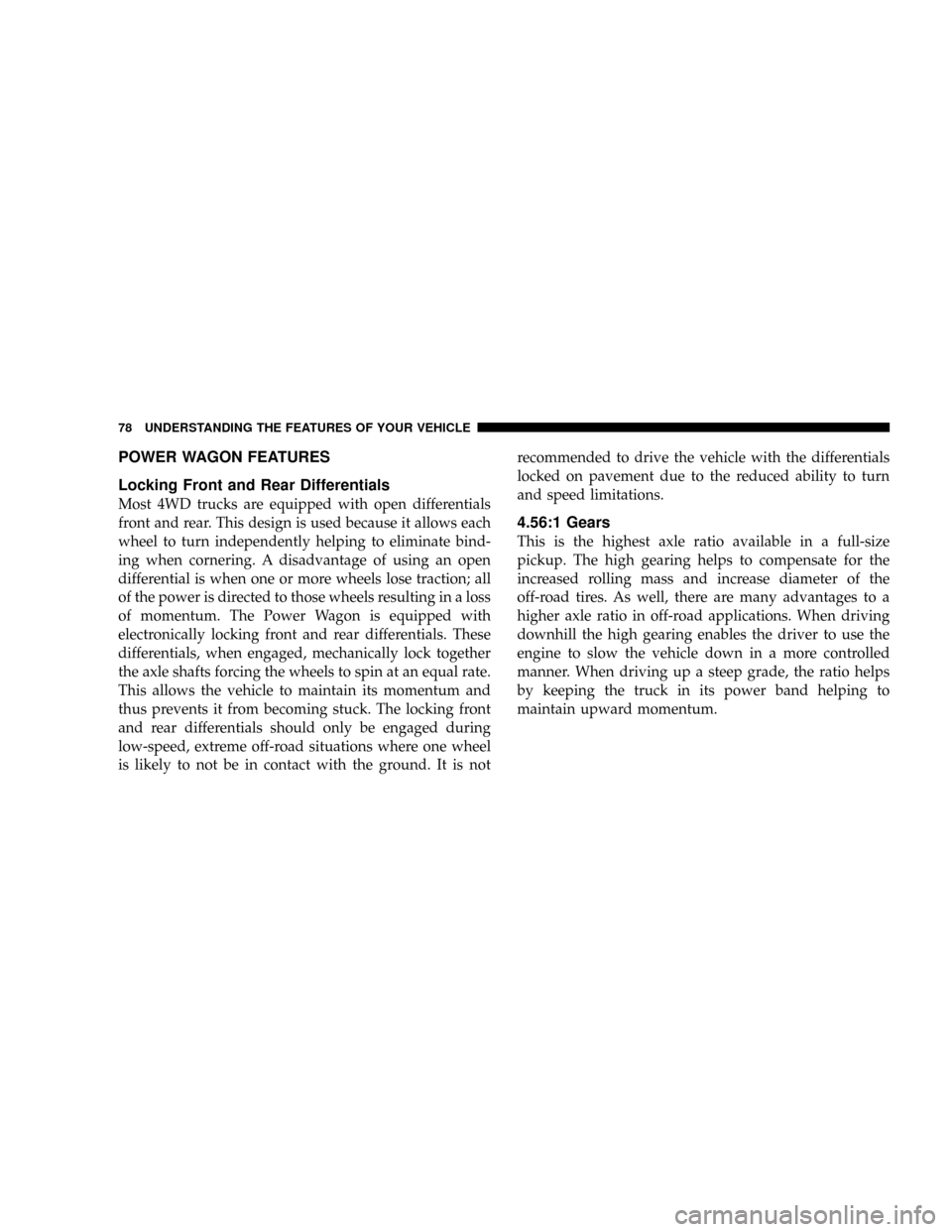
POWER WAGON FEATURES
Locking Front and Rear Differentials
Most 4WD trucks are equipped with open differentials
front and rear. This design is used because it allows each
wheel to turn independently helping to eliminate bind-
ing when cornering. A disadvantage of using an open
differential is when one or more wheels lose traction; all
of the power is directed to those wheels resulting in a loss
of momentum. The Power Wagon is equipped with
electronically locking front and rear differentials. These
differentials, when engaged, mechanically lock together
the axle shafts forcing the wheels to spin at an equal rate.
This allows the vehicle to maintain its momentum and
thus prevents it from becoming stuck. The locking front
and rear differentials should only be engaged during
low-speed, extreme off-road situations where one wheel
is likely to not be in contact with the ground. It is notrecommended to drive the vehicle with the differentials
locked on pavement due to the reduced ability to turn
and speed limitations.
4.56:1 Gears
This is the highest axle ratio available in a full-size
pickup. The high gearing helps to compensate for the
increased rolling mass and increase diameter of the
off-road tires. As well, there are many advantages to a
higher axle ratio in off-road applications. When driving
downhill the high gearing enables the driver to use the
engine to slow the vehicle down in a more controlled
manner. When driving up a steep grade, the ratio helps
by keeping the truck in its power band helping to
maintain upward momentum.
78 UNDERSTANDING THE FEATURES OF YOUR VEHICLE
Page 80 of 492
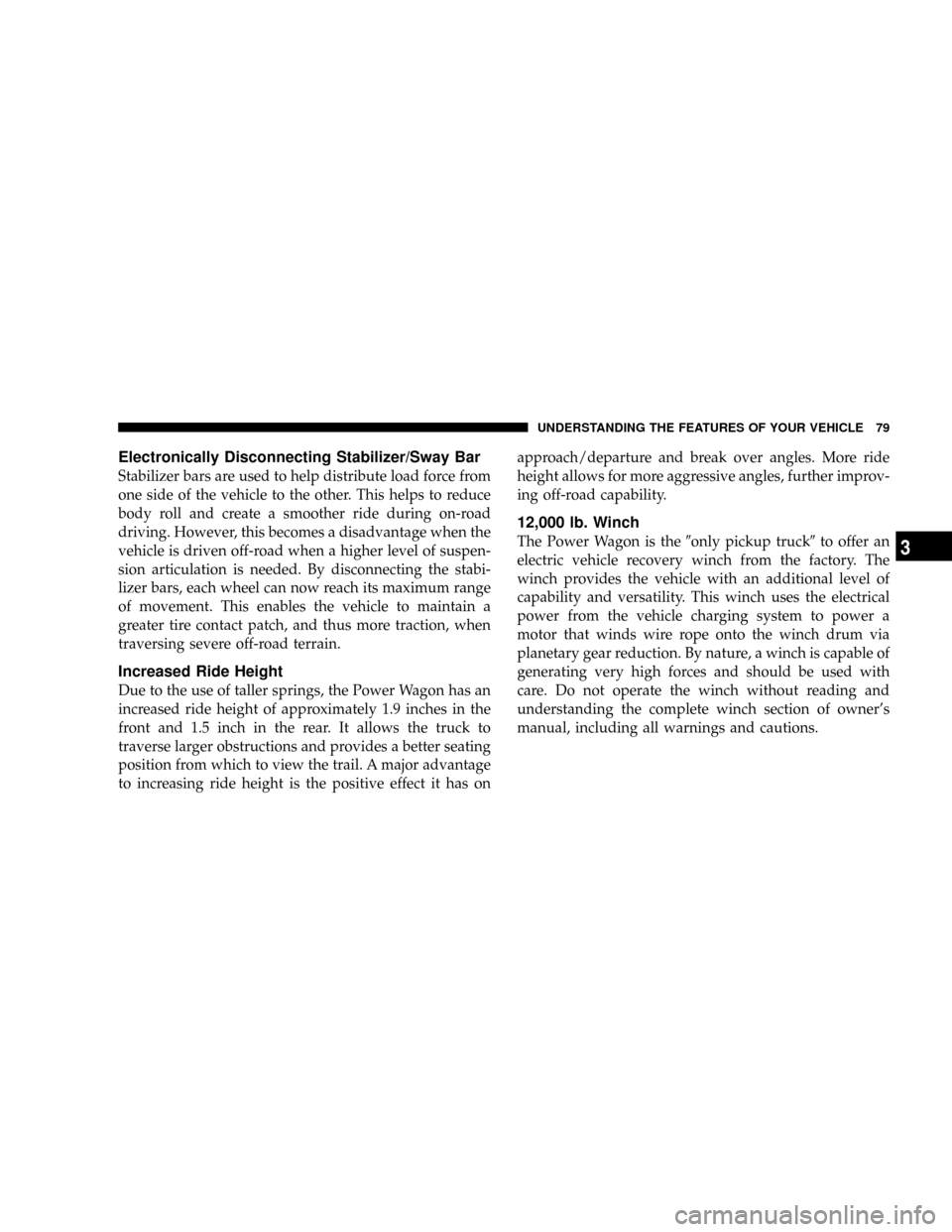
Electronically Disconnecting Stabilizer/Sway Bar
Stabilizer bars are used to help distribute load force from
one side of the vehicle to the other. This helps to reduce
body roll and create a smoother ride during on-road
driving. However, this becomes a disadvantage when the
vehicle is driven off-road when a higher level of suspen-
sion articulation is needed. By disconnecting the stabi-
lizer bars, each wheel can now reach its maximum range
of movement. This enables the vehicle to maintain a
greater tire contact patch, and thus more traction, when
traversing severe off-road terrain.
Increased Ride Height
Due to the use of taller springs, the Power Wagon has an
increased ride height of approximately 1.9 inches in the
front and 1.5 inch in the rear. It allows the truck to
traverse larger obstructions and provides a better seating
position from which to view the trail. A major advantage
to increasing ride height is the positive effect it has onapproach/departure and break over angles. More ride
height allows for more aggressive angles, further improv-
ing off-road capability.
12,000 lb. Winch
The Power Wagon is the9only pickup truck9to offer an
electric vehicle recovery winch from the factory. The
winch provides the vehicle with an additional level of
capability and versatility. This winch uses the electrical
power from the vehicle charging system to power a
motor that winds wire rope onto the winch drum via
planetary gear reduction. By nature, a winch is capable of
generating very high forces and should be used with
care. Do not operate the winch without reading and
understanding the complete winch section of owner's
manual, including all warnings and cautions.
UNDERSTANDING THE FEATURES OF YOUR VEHICLE 79
3